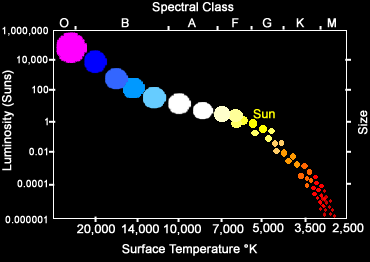Starlight - Main Sequence - O - B - A - F - G - K - M - Luminosity Classes - Spectral Class Codes

The largest, brightest stars exhaust their fuel supply in a few million years. The smallest stars will last for trillions of years.
About eighty-five percent of stars generate energy by fusing hydrogen in their cores. Stars with more hydrogen in their cores fuse it more rapidly and shine more brightly. When the size or luminosity of these stars is plotted against their temperature or spectral class, they line up neatly as shown in the graph. These stars are called Main Sequence Stars.
Astronomers use this sequence of letters to arrange stars into temperature or spectral classs: O, B, A, F, G, K, M.
O Type stars are the hottest, brightest and shortest lived. M type stars are the coolest, dimmest and longest lived. Star Timelines.
Numerals are used to subdivide the classes. The Sun is a G2 class star. The end points of the sequence are O3, the largest possible main sequence star type, through to M8, the smallest possible type of star.
Various other spectral classes have been proposed. For example: WC and WN for Wolf-Rayet stars, Q for exploding stars and R, N and S for various low mass peculiar stars, sometimes lumped together as C for Carbon stars. Such stars don't fit the standard scheme for a variety of reasons. They have unusal elements in their atmospheres. They have orbiting companions. They are surrounded by disks of dust and gas. They are too small to fully ignite their nuclear fuel. Astronomers learn much about the evolution of stars by studying those that don't fit the normal pattern.